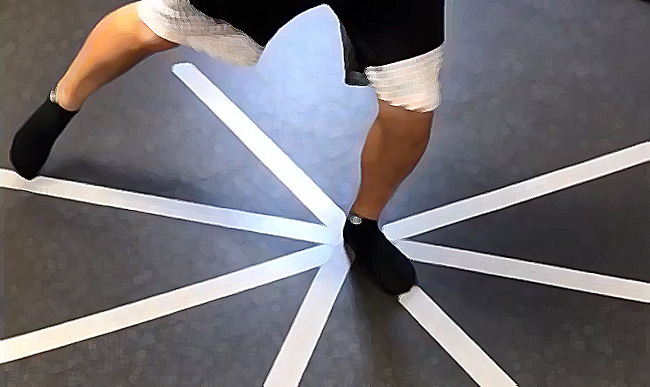The Star Excursion Balance Test (SEBT) is a test of dynamic balance, using in a single-leg stance that requires strength, flexibility, core control and proprioception. The test requires participants to balance on one leg and reach as far as possible in eight different directions. The similar Y-Balance Test was derived from this test.
purpose: To assess active balance and core control
equipment required: A flat, smooth, non-slip surface, measuring tape, marking tape. To prepare for the test, four 120cm lengths of marking tape are placed on to the floor, intersecting in the middle, and with the lines placed at 45-degree angles.
pre-test: Explain the test procedures to the subject. Perform screening of health risks and obtain informed consent. Prepare forms and record basic information such as age, height, body weight, gender, test conditions. Perform an appropriate warm-up. See more details of pre-test procedures.
procedure: The subject should be wearing lightweight and non-restrictive clothing and no footwear. The subject stands on one foot in the center of the star with their hands on their hips. They then reach with one foot as far as possible in one direction and lightly touch the line before returning back to the starting position. The support foot must stay flat on the ground. This is repeated for a full circuit, touching the line in every reach direction. The assessor should mark the spot on the line where the subject was able to reach. The test should be repeated three times for each foot. The trial is invalid if the subject cannot return to the starting position, the foot makes too heavy of a touch, or if the subject loses balance. see video.
 layout of the star excursion balance test, taken from this video
layout of the star excursion balance test, taken from this videoScoring: After the test all the reached distances are recorded to the nearest 0.5cm. Calculate Average distance in each direction (average of the three measurements) and Relative (normalised) distance in each direction (%) (average distance in each direction / leg length * 100). These calculations should be performed for both the right and left leg in each direction, providing a total of 16 scores per athlete.
Comments: this test has been used as an indicator of lower limb injury risk in a variety of populations
advantages: this is a simple test to perform with simple and inexpensive equipment.
disadvantages: the test can be time-consuming if it needs to be performed on a large group of individuals.
The Test in Action
Similar Tests
- A similar test, the y-balance test
Related Pages
- See a video about the Y Balance test
- About balance testing
- Other balance tests


 Current Events
Current Events